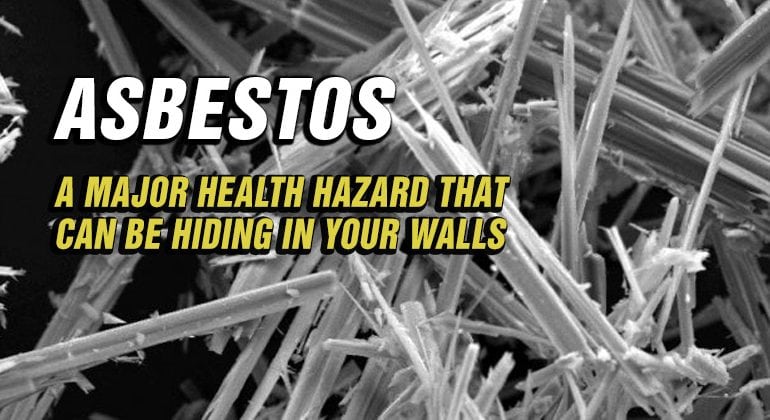The Main Principles Of Asbestos Removal
Table of ContentsLittle Known Facts About Asbestos Removal.4 Simple Techniques For Asbestos RemovalHow Asbestos Removal can Save You Time, Stress, and Money.The Main Principles Of Asbestos Removal
Ventilation requirements specified in paragraphs 1 and 2 of subsection 12( 3) help to ensure that employees in other parts of the workplace are not exposed to asbestos. In addition, the Guideline likewise needs a polyethylene enclosure if the workspace is not confined by walls and the operation is being carried on inside.The work area must be separated from the remainder of the office by walls, barricades, fencing, or other ways that are suitable in the situations - Asbestos Removal. Indoor Type 3 operations mentioned in subsection 18( 4) need using a polyethylene or other suitable enclosure unless walls enclose the work area. Negative atmospheric pressure should be maintained inside the enclosure unless the structure will be demolished and will just be entered by employees associated with the removal or by demolition employees.
Inspection and upkeep of the unfavorable air system, regular measurement of the unfavorable air pressure, and routine inspections of the work area (specifically the enclosure, barriers and decontamination center) are regulatory requirements that assist to lower airborne asbestos fibre concentrations inside the enclosure. All Type 3 operations need separation between the workspace and the rest of the workplace utilizing walls, barriers, fencing or other suitable means.
The Ultimate Guide To Asbestos Removal
In the case of a multilevel workspace in an outdoor Type 3 operation explained in paragraphs 1, 2, 3, and 4 of subsection 12( 4 ), such as an elimination on the side of a building that requires the use of scaffolding, the different work levels need to be separated so that dust and waste will not fall easily from one level to another.
If the work is done outdoors or if it is done in a structure that will be destroyed and will only be entered by the workers doing the asbestos elimination or by workers involved in the demolition, then negative air pressure does not need to be maintained inside the enclosure.
The Guideline likewise recommends hygiene practices and treatments to safeguard workers, including washing or shower centers, decontamination of individual protective clothes and equipment, the restriction of consuming, drinking, chewing and smoking, and the rigorous separation of tidy and contaminated clothing and equipment. Facilities for washing the hands and face must be attended to workers and the employees need to use them when leaving the work location.
Facilities for washing the face and hands should be offered and every employee must utilize these facilities as they leave the workspace. Employees who are performing Type 3 operations described in paragraphs 1, 2, 3, 4 and 6 of subsection 12( 4) should travel through a decontamination facility as they leave the workspace (Asbestos Removal).
Asbestos Removal Things To Know Before You Buy
If the work is done outdoors the decontamination center should be established as close as practicable to the work location. If the work is done inside the decontamination facility must be found so that the employees must go through it to enter and leave the work location. Nevertheless, in some scenarios it may be required for the company to use the arrangements of area 23 to vary the techniques and treatments set out in the Guideline to set up a remote decontamination center.

It is likewise advised that non-powered respirators be completely cleaned and, in the case of a filter respirator, the filter cartridges taken in the shower and disposed of on the unclean side of the shower. The worker then exits the shower from the tidy side, with the respirator, and wears street clothing or a brand-new set of coveralls that are kept in the clean space.
Facilities for cleaning the hands and face need to be provided and every employee needs to utilize these centers when leaving the workspace. The personal protective clothes and equipment required by the Guideline includes respirators, to manage the exposure of workers in the workspace, and protective clothing, to secure employees from secondary direct exposures and to prevent workers from transferring asbestos from the work area.
5 Simple Techniques For Asbestos Removal
To find out more on respirators see Chapter 12 (Asbestos Removal). Respirators authorized by the National Institute for Occupational Security and Health (NIOSH) might be utilized in Type 1 operations if the worker requests them and are required for Type 2 and Type 3 operations. Table 2 of the Guideline (see Chapter 12) sums up the respirator requirements for Type 1, Type 2, and Type 3 operations.
The requirements for protective clothing are set out in paragraph 12 of section 15 of the Guideline. It needs to: be made from product that does not keep or permit the penetration of asbestos fibers, consist of suitable footwear and a More Info head covering, and consist of a complete body covering that fits comfortably at the wrists, ankles and neck.
They can be quickly torn, nevertheless, and need to be repaired or changed when this takes place. The option of appropriate shoes is reliant on the kind of work. High leading rubber boots are perfect for wet removal work, and are readily available as security footwear. Standard security boots look what i found or security shoes may be better suited for other kinds of work.